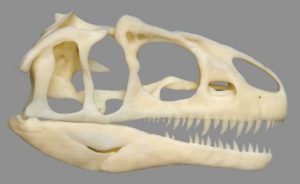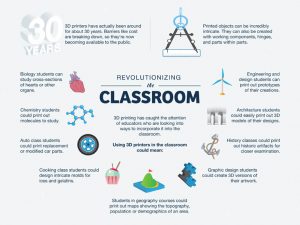by Chantal Petgrave, 3D Printing peer tutor, Humanities & Social Sciences Library
3D printing has yet to significantly influence the education system, but holds the potential completely re-define the way students learn and interact in a classroom setting. McGill University is extremely lucky to have access to three 3D printers at the post-secondary study level, but there have been studies that have proven introducing 3D printing at an earlier stage in the educational system could prove to be more beneficial for students. Specifically because the younger a person is, the easier it usually is to introduce new ideas and concepts and this is what makes elementary schools, junior high schools, and high schools the perfect place to begin really introducing a curriculum based around 3D printing. It would prompt the minds of youth to work in innovative ways to push past boundaries and discover new capacities.
There are various areas where 3D printing could be incorporated in the classroom, as a large part of education is developing diverse ways for students to understand the material. Teachers could use 3D printing to promote visual learning for younger students, and older students could use it as a teaching aid.  One specific area where it could be applied is mathematics, where students could use 3D printing to create tangible representations of equations, elaborate graphs, and complex mathematical models. It could also extend to geography, where writers of textbooks could integrate 3D printing into lesson plans, and include files for printable models with each chapter in their books. Just take a moment and imagine printing out scaled down models of certain mountain ranges, continents and other landmarks, it would be a way to give kids a hands-on look at famous locations around the world without having to actually be there. Thirdly, history is another field that could benefit; Museums around the world are finally beginning to see the potential that 3D scanning and printing can have on making replicas of ancient artifacts. Previously, when you would visit a museum, you could “look but not touch” the artifacts. Now with the availability of high-end 3D printers and scanners, replicas can be touched, and many of these replicas are virtually indistinguishable from their real counterparts.
One specific area where it could be applied is mathematics, where students could use 3D printing to create tangible representations of equations, elaborate graphs, and complex mathematical models. It could also extend to geography, where writers of textbooks could integrate 3D printing into lesson plans, and include files for printable models with each chapter in their books. Just take a moment and imagine printing out scaled down models of certain mountain ranges, continents and other landmarks, it would be a way to give kids a hands-on look at famous locations around the world without having to actually be there. Thirdly, history is another field that could benefit; Museums around the world are finally beginning to see the potential that 3D scanning and printing can have on making replicas of ancient artifacts. Previously, when you would visit a museum, you could “look but not touch” the artifacts. Now with the availability of high-end 3D printers and scanners, replicas can be touched, and many of these replicas are virtually indistinguishable from their real counterparts.
It is often said that, “today’s youth are tomorrow’s future…” with that in mind, it is important to consider just how beneficial it could be to have youth learn the basics of 3D printing through the educational system. We are living in an era of innovation and new technology, but schools seem to be stuck in a repetitive prehistoric way of teaching, and while new technology can be quite scary, especially to those older generations who have a tendency to be less keen on changing their ways— but changes need to be made. The introduction of 3D printing into schools is one of these that should be taken into consideration by every single school in the world.
For more information on 3D printing, see Chantal’s post 3D printing 101 – an introduction, that appeared on Library Matters in January 2017.
Dinosaur – Stratasys [link]
Revolutionizing the classroom – 3D Printing Systems [link]

